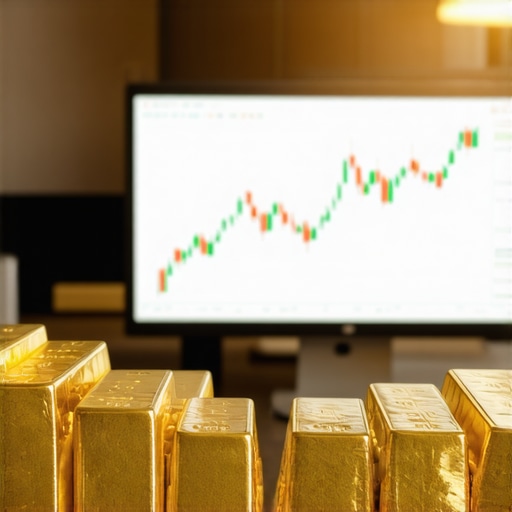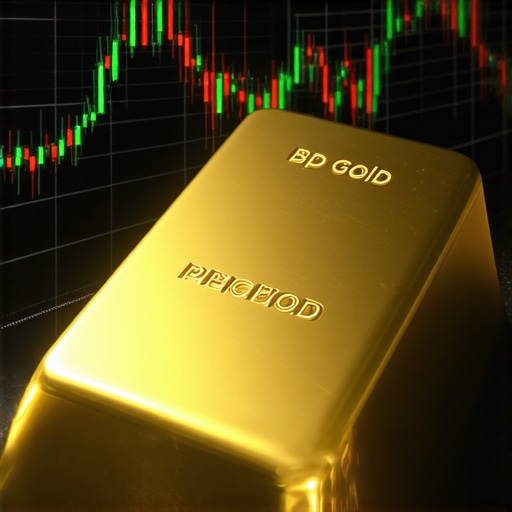Understanding Gold Price Forecasts: What Investors Need to Know
As a seasoned investor or someone just starting in the world of commodities, understanding gold price forecasts is essential for making informed decisions. Gold has been a traditional safe haven for investors, especially during times of economic uncertainty. With the global economy constantly evolving, staying ahead of trends in gold prices is crucial. This article delves into various factors influencing gold prices, including market dynamics, geopolitical events, and investor sentiment, providing insights that savvy investors can leverage.
Factors Influencing Gold Prices
Gold prices are influenced by a myriad of factors, each playing a significant role in its valuation. Economic indicators such as inflation rates, interest rates, and currency fluctuations can substantially impact gold prices. For instance, when inflation rises, investors often flock to gold as a hedge against diminishing purchasing power. Similarly, low-interest rates can make gold more appealing compared to interest-bearing assets, driving up its price.
Geopolitical tensions also play a critical role. Events such as trade wars, military conflicts, or changes in government policies can create uncertainty in the markets, prompting investors to turn to gold for safety. Understanding these geopolitical dynamics is essential for predicting potential shifts in gold prices. For a deeper analysis of how geopolitical events influence gold prices, check out our article on the impact of geopolitical events on gold prices.
Market Demand and Supply Insights
Another key aspect of gold price forecasts is the balance of supply and demand in the market. As the demand for gold increases—whether from jewelry, industrial uses, or investment—prices tend to rise. Conversely, if supply outpaces demand, prices may drop. Recent trends have shown fluctuations in gold supply due to mining output and recycling rates. For investors, understanding these trends can help in predicting future price movements. For more insights on supply and demand dynamics, explore our post on gold supply and demand insights.
Predictions for the Future: What to Expect
Looking ahead, many analysts provide predictions based on current market conditions and historical data. Various forecasting models take into account economic indicators, historical price trends, and market sentiment to offer a view on where gold prices might be headed. For instance, as we approach 2025, predictions suggest that gold could see significant price movements driven by the aforementioned factors. Investors should keep a close eye on these forecasts and adjust their strategies accordingly.
In addition to keeping up with forecasts, understanding the broader market context is essential. Factors such as changes in global economic policies, the strength of the US dollar, and shifts in investor appetite for risk can all impact gold prices. Savvy investors should remain informed about these trends and consider them when making investment decisions.
For those looking to navigate the complexities of the gold market, a practical guide can be invaluable. Our comprehensive guide on investing in gold offers a wealth of information for both new and seasoned investors alike, ensuring you are well-equipped to make informed decisions as the market evolves.
Analyzing the Impact of Economic Indicators on Gold Prices
Understanding economic indicators is crucial for predicting gold price movements. Key metrics such as inflation rates, employment numbers, and GDP growth can provide insights into future gold trends. For instance, rising inflation often leads investors to seek refuge in gold, driving prices up. Similarly, economic downturns or weak job reports can lead to increased gold demand as a safe-haven asset. For a deeper dive into how economic factors play a role in your investment strategy, check out our article on key factors influencing gold prices.
Technical Analysis: Charting the Future of Gold Prices
Technical analysis involves studying historical price charts and patterns to forecast future price movements. Investors often use various tools, such as moving averages and trend lines, to identify potential entry and exit points. By recognizing patterns, investors can make more informed decisions about when to buy or sell gold. Resources like our guide on analyzing trends in the gold market can enhance your understanding of effective technical strategies.
Geopolitical Events: The Unpredictable Influencers
Geopolitical events can significantly sway gold prices. From conflicts to trade agreements, any significant event can trigger volatility in the market. Investors should stay informed about global politics, as these factors often create uncertainty, which traditionally boosts gold prices. For more insights on this topic, read our article on the impact of geopolitics on gold prices. Staying updated on current events can help investors anticipate changes in gold valuation.
Investment Strategies: Preparing for Future Trends
As gold prices fluctuate, having a solid investment strategy is essential. Diversifying your portfolio to include gold can help mitigate risks associated with other asset classes. Investors can consider various forms of gold investments, from physical gold to gold ETFs. Each option has its advantages and disadvantages, which investors should weigh carefully. For those who are new to gold investing, our comprehensive guide on investing in gold for beginners offers valuable insights.
The Role of Central Banks in Gold Price Dynamics
Central banks play a pivotal role in the gold market. Their purchasing and selling activities can influence gold prices significantly. For instance, when central banks increase their gold reserves, it often signals confidence in gold as a stable asset, which can lead to higher prices. Understanding the trends in central bank gold purchases can provide investors with insights into future price movements. For a detailed discussion on this topic, explore our article on how central bank purchases affect prices.
Conclusion: Staying Ahead in the Gold Market
In conclusion, staying informed about the various factors that influence gold prices is vital for investors looking to navigate this complex market. By understanding economic indicators, utilizing technical analysis, and keeping an eye on geopolitical events, investors can position themselves for success. As we continue to explore the future of gold investments, be sure to check back for more insights that can enhance your investment strategy.
Investment Strategies: Preparing for Future Trends in Gold
As gold prices fluctuate, having a solid investment strategy is essential for both seasoned and novice investors. Diversifying your portfolio to include gold can help mitigate risks associated with other asset classes. Investors can consider various forms of gold investments, from physical gold to gold ETFs, each with its unique advantages and disadvantages. For those who are new to gold investing, our comprehensive guide on investing in gold for beginners offers valuable insights into getting started.
Understanding Different Gold Investment Options
Investors have multiple options when it comes to gold. Physical gold, such as coins and bullion, provides a tangible asset. However, it requires secure storage and insurance. On the other hand, gold ETFs (Exchange-Traded Funds) offer a more liquid investment without the need for physical storage. They track the price of gold and can be traded like stocks. For more information on ETFs, check out our article on the best gold ETFs for your portfolio.
Long-Term vs. Short-Term Investment Strategies
When investing in gold, it’s crucial to determine your investment horizon. Long-term investors might focus on the overall appreciation of gold prices over time, while short-term traders may capitalize on daily price fluctuations. Each strategy requires a different approach and understanding of market trends. For those interested in trading strategies, our post on analyzing gold trading techniques can provide valuable tips.
Risk Management in Gold Investments
Effective risk management is vital for any investment strategy. Understanding the volatility of gold prices can help investors make informed decisions. Strategies such as setting stop-loss orders or diversifying among different types of gold investments can mitigate risks. Additionally, investors should stay updated on market news and economic indicators that may impact gold prices. For insights on how to evaluate market risks, our article on evaluating gold market analysis is essential reading.
Monitoring Economic Indicators
Keeping an eye on economic indicators such as inflation, interest rates, and employment figures is crucial when investing in gold. These factors can influence gold prices significantly. For example, rising inflation often leads investors to seek refuge in gold, driving prices up. Understanding these economic signals can aid in timing your investments effectively.
Utilizing Technical Analysis for Gold Trading
Technical analysis involves studying historical price charts and patterns to forecast future price movements. Investors often use tools like moving averages and trend lines to identify potential entry and exit points. By recognizing patterns, investors can make more informed decisions about when to buy or sell gold. Resources like our guide on analyzing trends in the gold market can enhance your understanding of effective technical strategies.
In addition to technical analysis, integrating fundamental analysis—examining the factors that affect supply and demand—can provide a well-rounded investment approach. Understanding both aspects can significantly enhance your trading success.
Leveraging Central Bank Activities
Central banks play a pivotal role in the gold market. Their purchasing and selling activities can influence gold prices significantly. For instance, when central banks increase their gold reserves, it often signals confidence in gold as a stable asset, which can lead to higher prices. Understanding the trends in central bank gold purchases can provide investors with insights into future price movements. For a detailed discussion on this topic, explore our article on how central bank purchases affect prices.
As you refine your investment strategies, staying informed about these factors can position you to take advantage of market opportunities and navigate the complexities of gold investments effectively.
Investment Strategies for Gold: Preparing for Future Trends
As gold prices fluctuate, having a solid investment strategy is essential for both seasoned and novice investors. Diversifying your portfolio to include gold can help mitigate risks associated with other asset classes. Investors can consider various forms of gold investments, from physical gold to gold ETFs, each with its unique advantages and disadvantages. For those who are new to gold investing, our comprehensive guide on investing in gold for beginners offers valuable insights into getting started.
Understanding Different Gold Investment Options
Investors have multiple options when it comes to gold. Physical gold, such as coins and bullion, provides a tangible asset. However, it requires secure storage and insurance. On the other hand, gold ETFs (Exchange-Traded Funds) offer a more liquid investment without the need for physical storage. They track the price of gold and can be traded like stocks. For more information on ETFs, check out our article on the best gold ETFs for your portfolio.
Long-Term vs. Short-Term Investment Strategies
When investing in gold, it’s crucial to determine your investment horizon. Long-term investors might focus on the overall appreciation of gold prices over time, while short-term traders may capitalize on daily price fluctuations. Each strategy requires a different approach and understanding of market trends. For those interested in trading strategies, our post on analyzing gold trading techniques can provide valuable tips.
Risk Management in Gold Investments
Effective risk management is vital for any investment strategy. Understanding the volatility of gold prices can help investors make informed decisions. Strategies such as setting stop-loss orders or diversifying among different types of gold investments can mitigate risks. Additionally, investors should stay updated on market news and economic indicators that may impact gold prices. For insights on how to evaluate market risks, our article on evaluating gold market analysis is essential reading.
Monitoring Economic Indicators
Keeping an eye on economic indicators such as inflation, interest rates, and employment figures is crucial when investing in gold. These factors can influence gold prices significantly. For example, rising inflation often leads investors to seek refuge in gold, driving prices up. Understanding these economic signals can aid in timing your investments effectively.
Utilizing Technical Analysis for Gold Trading
Technical analysis involves studying historical price charts and patterns to forecast future price movements. Investors often use tools like moving averages and trend lines to identify potential entry and exit points. By recognizing patterns, investors can make more informed decisions about when to buy or sell gold. Resources like our guide on analyzing trends in the gold market can enhance your understanding of effective technical strategies.
In addition to technical analysis, integrating fundamental analysis—examining the factors that affect supply and demand—can provide a well-rounded investment approach. Understanding both aspects can significantly enhance your trading success.
Leveraging Central Bank Activities
Central banks play a pivotal role in the gold market. Their purchasing and selling activities can influence gold prices significantly. For instance, when central banks increase their gold reserves, it often signals confidence in gold as a stable asset, which can lead to higher prices. Understanding the trends in central bank gold purchases can provide investors with insights into future price movements. For a detailed discussion on this topic, explore our article on how central bank purchases affect prices.
As you refine your investment strategies, staying informed about these factors can position you to take advantage of market opportunities and navigate the complexities of gold investments effectively.
Comprehensive FAQ Section on Gold Price Forecasts
What factors affect gold prices?
Gold prices are influenced by a variety of factors including economic indicators like inflation and interest rates, geopolitical events, market demand and supply dynamics, and the activities of central banks. These elements play a crucial role in determining the value of gold in the market.
How can I predict future gold prices?
Future gold prices can be predicted by analyzing economic data, employing technical analysis on historical price charts, and keeping a lookout for geopolitical developments. Investors often utilize a combination of fundamental and technical analyses to forecast potential price movements.
Is investing in gold a safe investment?
Gold is often considered a safe-haven asset, particularly during times of economic uncertainty. However, like all investments, it carries risks. It’s essential to understand market dynamics and diversify your portfolio to mitigate these risks effectively.
What are the different ways to invest in gold?
Investors can choose from several options when investing in gold, including physical gold (like coins and bullion), gold ETFs, gold mining stocks, and gold futures. Each option has its own risk profile and benefits, so it’s essential to evaluate which aligns best with your investment strategy.
What is the impact of central banks on gold prices?
Central banks can significantly influence gold prices through their buying and selling activities. When central banks increase their gold reserves, it often boosts investor confidence in gold, leading to higher prices. Conversely, selling off gold reserves can decrease demand and lower prices.
How do geopolitical events affect gold prices?
Geopolitical events, such as conflicts, trade wars, and changes in government policies, create uncertainty in the markets. This uncertainty typically drives investors toward gold as a safe investment, leading to price increases. Staying informed about global politics is essential for anticipating changes in gold valuation.
Can gold prices rise indefinitely?
While gold prices can experience significant increases, they are subject to market forces and economic conditions. Factors like changes in investor sentiment, economic recovery, and shifts in supply and demand can all impact gold prices, so they may not rise indefinitely.
What are gold ETFs and how do they work?
Gold ETFs, or Exchange-Traded Funds, are investment funds that track the price of gold. They allow investors to gain exposure to gold without the need for physical storage. Gold ETFs can be traded on stock exchanges similar to stocks, providing liquidity and ease of access for investors.
How do inflation rates affect gold prices?
Rising inflation rates typically lead to increased demand for gold as a hedge against declining purchasing power. Investors often turn to gold during inflationary periods, driving prices higher. Monitoring inflation trends is crucial for predicting potential movements in gold prices.
What resources can I use for gold investment research?
For reliable information on gold investment, consider authoritative sources such as the World Gold Council, financial news sites like Bloomberg and Reuters, and expert analyses from investment firms. Additionally, books and articles by financial experts can provide valuable insights into gold investment strategies.
Authority Resources for Gold Investment Research
For those looking to deepen their understanding of gold investments, several reputable resources are available:
- World Gold Council – A leading authority on gold, providing comprehensive market insights and research.
- Bloomberg Gold Market – Offers up-to-date news and analysis on gold prices and market trends.
- Reuters Commodities – Provides timely news and expert opinions on gold and other commodities.
- Kitco Metals – A trusted source for precious metals market information and price tracking.
- Investing.com Gold – Offers charts, news, and analysis on gold investment opportunities.
Conclusion: Navigating the Gold Market for Successful Investments
In conclusion, understanding the various factors influencing gold prices is crucial for investors seeking to navigate this complex market. By staying informed about economic indicators, geopolitical dynamics, and utilizing effective investment strategies, both new and seasoned investors can make informed decisions. Whether you’re considering long-term investments or short-term trading strategies, having a comprehensive grasp of gold price forecasts will empower you to leverage opportunities as they arise, ensuring you remain competitive in the ever-evolving gold market.










I appreciated how this article separates the signal sources — economic indicators, geopolitics, supply/demand and central bank activity — because in practice those drivers move at different speeds. My own approach has been to treat gold as a strategic hedge rather than a trading gimmick: roughly 10% of my portfolio in physical coins for tail-risk protection and another 8–12% in a diversified mix of gold ETFs for liquidity. For timing shorter moves I combine a couple of technicals (50/200-day moving average cross and RSI) with macro checks — especially real U.S. yields and the DXY dollar index — since I’ve noticed gold tends to rally when real yields fall and the dollar weakens. One nuance I’d add: central bank buying is a slow, structural tailwind, but recycling and mine output can mute rallies in the short term. Has anyone here developed rules to rebalance between physical and ETF exposure during spikes? Or do you rely more on macro signals (inflation/real yields) versus chart setups when deciding to add to gold positions?
I found this article quite comprehensive, especially in how it covers the various drivers behind gold price movements. In my experience, understanding the interplay between macroeconomic indicators like inflation and interest rates is vital, but I’ve noticed geopolitical stability also plays a key role, especially during uncertain times. I typically keep an eye on central bank policies since their gold reserve activities can subtly influence prices over the long run. That said, I wonder how other investors balance their physical gold holdings against ETFs, particularly during volatile periods. Do you find that rebalancing based on macroeconomic signals tends to be more effective than relying on technical charting? Personally, I lean towards macro forecasts for longer-term decisions but then incorporate some technical analysis for tactical entries or exits. Curious to hear how others approach this—do you prefer a more data-driven model or a flexible, intuitive approach based on market sentiment? It’s a nuanced topic, and I’d love to hear diverse perspectives.